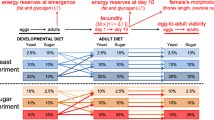Abstract
We examined the relationship of genetic quality to age in male Drosophila melanogaster to test two contrasting hypotheses. The traditional hypothesis is that older males have proven their viability and therefore produce offspring of superior genetic quality. This hypothesis is often evoked as an explanation for female preference for older mates. In contrast, we have recently argued that older fathers may produce offspring of inferior genetic quality. Here, we present results from an experiment designed to measure the genetic quality of offspring produced by 2 day old, 2 week old and 5 week old male D. melanogaster. We found a statistically significant small reduction in larval viability and a similar but statistically non-significant reduction in son mating ability among the offspring of the 5 week old males. Daughter fecundity showed no apparent trend for a reduction nor an increase in performance with increasing age of the fathers. There was no evidence of a difference between the 2 day old and the 2 week old males for any of these three fitness components. These results are in somewhat better accordance with our alternative hypothesis, but the relatively weak and late occurring effects indicate that mate choice based on age may not be a viable strategy in this population.
Similar content being viewed by others
REFERENCES
Alatalo, R., Gustafsson, V. L. and Lundberg, A. (1986). Do females prefer older males in polygynous bird species? American Naturalist 127:241–245.
Andersson, M. (1994). Sexual selection. New Jersey: Princeton University Press.
Burt, A. (1995). The evolution of fitness. Evolution 49:1–8.
Charlesworth, B. 1990. Optimization models, quantitative genetics, and mutation. Evolution 44:520–538.
Charlesworth, B. and Charlesworth, D. (1985). Genetic variation in recombination in Drosophila. I. Responses to selection and preliminary genetic analysis. Heredity 54:71–84.
Crow, J. F. (1993). How much do we know about spontaneous human mutation rates? Environmental and Molecular Mutagensis 21:122–129.
Hansen, T. F. and Price, D. K. (1995). Good genes and old age: Do old mates provide superior genes? Journal of Evolutionary Biology 8:759–778.
Houle, D. (1991). Genetic covariance of fitness correlates: what genetic correlations are made of and why it matters. Evolution 45:630–648.
Howard, R. D., Whiteman, H. H. and Schueller, T. I. (1994). Sexual selection in American toads: A test of a good-genes hypothesis. Evolution 48:1286–1300.
Hughes, K. A. (1995). The evolutionary genetics of male life-history characters in Drosophila melanogaster. Evolution 49:521–537
Kokko, H. and J. Lindstrøm. (1996). Evolution of female preference for old mates. Proc. R. Soc. Lond. B 263:1533–1538
Lindsey, D. L. and Grell, E. H. (1972). Genetic variations of Drosophila melanogaster. Washington: Carnegie Institution: Publication 627.
Luckinbill, L. S., Arkin, R., Clare, M. J., Cirocco, W. C. and Buck, S. A. (1984). Selection for delayed senescence in Drosophila melanogaster. Evolution 38:996–1003
Manning, J. T. (1985). Choosy females and correlates of male age. Journal of Theoretical Biology 116:349–354.
Partridge, L. (1980). Mate choice increases a component of offspring fitness in fruit flies. Nature 283:290–291.
Price, D. K. and Sigurdardottir, H. (in prep). Spontaneous mutations and sexual selection in Drosophila.
Rice, W. R. (1988). Heritable variation in fitness as a prerequisite for adaptive female choice: the effect of mutation-selection balance. Evolution 42:817–820.
Rose, M. R. (1991). Evolutionary biology of aging. Oxford: Oxford University Press.
SAS Institute Inc. (1988). SAS/STAT user's guide, Release 6.03 Edition. SAS Institute Inc., North Carolina.
Stearns, S. C. (1992). The Evolution of Life Histories. Oxford: Oxford University Press.
Tatar, M., Promislow, D. E. L., Khazaeli, A. and Curtsinger, J. W. (1996). Age-specific patterns of genetic variation in Drosophila melanogaster: II. Fecundity and its genetic correlation with age-specific mortality. Genetics 143:849–858.
Trivers, R. L. (1972). Parental investment and sexual selection. Pp. 136–179 in B. Campbell, ed. Sexual selection and the descent of man, 1871–1971. Aldine Press, Chicago.
Zar, J. H. (1986). Biostatistical Analysis, 3rd ed. New Jersey: Prentice-Hall Press.
Author information
Authors and Affiliations
Rights and permissions
About this article
Cite this article
Price, D.K., Hansen, T.F. How Does Offspring Quality Change with Age in Male Drosophila Melanogaster?. Behav Genet 28, 395–402 (1998). https://doi.org/10.1023/A:1021677804038
Issue Date:
DOI: https://doi.org/10.1023/A:1021677804038




